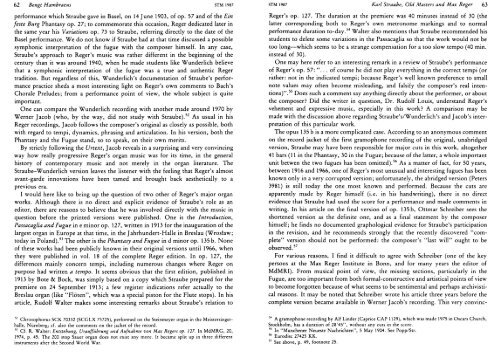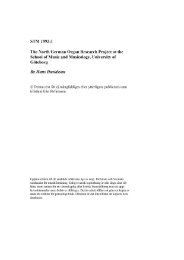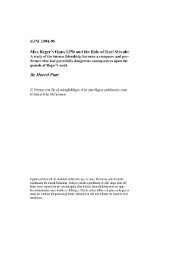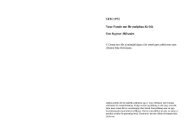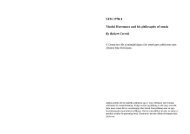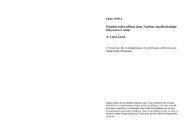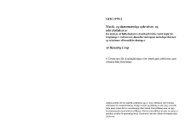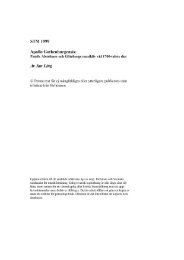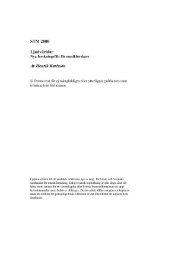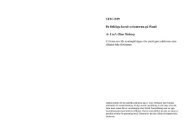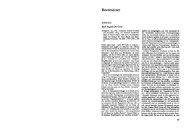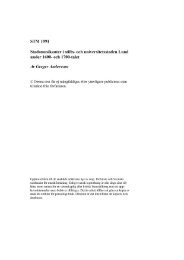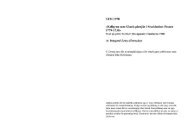Create successful ePaper yourself
Turn your PDF publications into a flip-book with our unique Google optimized e-Paper software.
performance which Straube gave in Basel, on 14 June 1903, of op. 57 and of the Ein<br />
feste Burg Phantasy op. 27; to commemorate this occasion, Reger dedicated later in<br />
the same year his Variations op. 73 to Straube, referring directly to the date of the<br />
Basel performance. We do not know if Straube had at that time discussed a possible<br />
symphonic interpretation of the fugue with the composer himself. In any case,<br />
Straube’s approach to Reger’s music was rather different in the beginning of the<br />
century than it was around 1940, when he made students like Wunderlich believe<br />
that a symphonic interpretation of the fugue was a true and authentic Reger<br />
tradition. But regardless of this, Wunderlich’s documentation of Straube’s perfor-<br />
mance practice sheds a most interesting light on Reger’s own comments to Bach’s<br />
Chorale Preludes; from a performance point of view, the whole subject is quite<br />
important.<br />
One can compare the Wunderlich recording with another made around 1970 by<br />
Werner Jacob (who, by the way, did not study with Straube).52 As usual in his<br />
Reger recordings, Jacob follows the composer’s original as closely as possible, both<br />
with regard to tempi, dynamics, phrasing and articulation. In his version, both the<br />
Phantasy and the Fugue stand, so to speak, on their own merits.<br />
<strong>By</strong> strictly following the Urtext, Jacob reveals in a surprising and very convincing<br />
way how really progressive Reger’s organ music was for its time, in the general<br />
history of contemporary music and not merely in the organ literature. The<br />
Straube-Wunderlich version leaves the listener with the feeling that Reger’s almost<br />
avant-garde innovations have been tamed and brought back aesthetically to a<br />
previous era.<br />
I would here like to bring up the question of two other of Reger’s major organ<br />
works. Although there is no direct and explicit evidence of Straube’s role as an<br />
editor, there are reasons to believe that he was involved directly with the music in<br />
question before the printed versions were published. One is the Introduction,<br />
Passacaglia and Fugue in e minor op. 127, written in 1913 for the inauguration of the<br />
largest organ in Europe at that time, in the Jahrhundert-Halle in Breslau (Wroslaw;<br />
today in Poland).53 The other is the Phantasy and Fugue in d minor op. 135 b. None<br />
of these works had been publicly known in their original versions until 1966, when<br />
they were published in vol. 18 of the complete Reger edition. In op. 127, the<br />
differences mainly concern tempi, including numerous changes where Reger on<br />
purpose had written a tempo. It seems obvious that the first edition, published in<br />
1913 by Bote & Bock, was simply based on a copy which Straube prepared for the<br />
premiere on 24 September 1913; a few register indications refer actually to the<br />
Breslau organ (like “Flöten’’, which was a special piston for the Flute stops). In his<br />
article, Rudolf Walter makes some interesting remarks about Straube’s relation to<br />
52 Christophorus SCK 70332 (SCGLX 73725), performed on the Steinmeyer organ in the Meistersinger-<br />
halle, Nürnberg; cf. also the comments on the jacket of the record.<br />
53 Cf. R. Walter: Entstehung, Uraufführung und Aufnahme von Max Regers op. 127. In MdMRG, 20,<br />
1974, p. 45. The 200 stop Sauer organ does not exist any more. It became split up in three different<br />
instruments after the Second World War.<br />
Reger’s op. 127. The duration at the premiere was 40 minutes instead of 30 (the<br />
latter corresponding both to Reger’s own metronome markings and to normal<br />
performance duration to-day. 54 Walter also mentions that Straube recommended his<br />
students to delete some variations in the Passacaglia so that the work would not be<br />
too long-which seems to be a strange compensation for a too slow tempo (40 min.<br />
instead of 30).<br />
One may here refer to an interesting remark in a review of Straube’s performance<br />
of Reger’s op. 57: “... of course he did not play everything in the correct tempi (or<br />
rather: not in the indicated tempi; because Reger’s well known preference to small<br />
note values may often become misleading, and falsify the composer’s real intention~)”,’~<br />
Does such a comment say anything directly about the performer, or about<br />
the composer? Did the writer in question, Dr. Rudolf Louis, understand Reger’s<br />
vehement and expressive music, especially in this work? A comparison may be<br />
made with the discussion above regarding Straube’s/Wunderlich’s and Jacob’s interpretation<br />
of this particular work.<br />
The opus 135 b is a more complicated case. According to an anonymous comment<br />
on the record jacket of the first gramophone recording of the original, unabridged<br />
version, Straube may have been responsible for major cuts in this work, altogether<br />
41 bars (i 1 in the Phantasy, 30 in the Fugue; because of the latter, a whole important<br />
unit betwen the two fugues has been omitted).56 As a matter of fact, for 50 years,<br />
between 1916 and 1966, one of Reger’s most unusual and interesting fugues has been<br />
known only in a very corrupted version; unfortunately, the abridged version (Peters<br />
3981) is still today the one most known and performed. Because the cuts are<br />
apparently made by Reger himself (i.e. in his handwriting), there is no direct<br />
evidence that Straube had used the score for a performance and made comments in<br />
writing. In his article on the final version of op. 135 b, Ottmar Schreiber sees the<br />
shortened version as the definite one, and as a final statement by the composer<br />
himself; he finds no documented graphological evidence for Straube’s participation<br />
in the revision, and he recommends strongly that the recently discovered “complete”<br />
version should not be performed: the composer’s “last will” ought to be<br />
observed.”<br />
For various reasons, I find it difficult to agree with Schreiber (one of the key<br />
persons at the Max Reger Institute in Bonn, and for many years the editor of<br />
MdMRI). From musical point of view, the missing sections, particularly in the<br />
Fugue, are too important from both formal-constructive and artistical points of view<br />
to become forgotten because of what seems to be sentimental and perhaps archivistical<br />
reasons. It may be noted that Schreiber wrote his article three years before the<br />
complete version became available in Werner Jacob’s recording. This very convint-<br />
54 A gramophone recording by Alf Linder (Caprice CAP i 129), which was made 1975 in Oscars Church,<br />
Stockholm, has a duration of 28‘45”, without any cuts in the score.<br />
55 In “Munchener Neueste Nachrichten”, 5 May 1904. See Popp/Str.<br />
56 Eurodisc 27425 KK.<br />
57 See above, p. 49, footnote 25.


